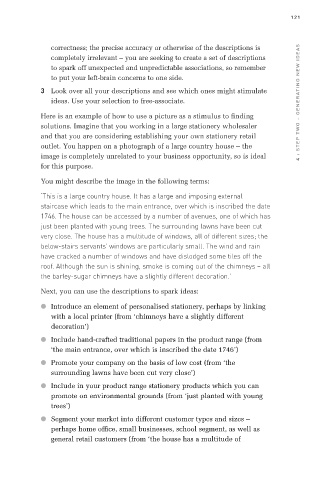Page 144 - DNBI_A01.QXD
P. 144
1214 : STEP TWO – GENERATING NEW IDEAS
correctness; the precise accuracy or otherwise of the descriptions is
completely irrelevant – you are seeking to create a set of descriptions
to spark off unexpected and unpredictable associations, so remember
to put your left-brain concerns to one side.
3 Look over all your descriptions and see which ones might stimulate
ideas. Use your selection to free-associate.
Here is an example of how to use a picture as a stimulus to finding
solutions. Imagine that you working in a large stationery wholesaler
and that you are considering establishing your own stationery retail
outlet. You happen on a photograph of a large country house – the
image is completely unrelated to your business opportunity, so is ideal
for this purpose.
You might describe the image in the following terms:
‘This is a large country house. It has a large and imposing external
staircase which leads to the main entrance, over which is inscribed the date
1746. The house can be accessed by a number of avenues, one of which has
just been planted with young trees. The surrounding lawns have been cut
very close. The house has a multitude of windows, all of different sizes; the
below-stairs servants’ windows are particularly small. The wind and rain
have cracked a number of windows and have dislodged some tiles off the
roof. Although the sun is shining, smoke is coming out of the chimneys – all
the barley-sugar chimneys have a slightly different decoration.’
Next, you can use the descriptions to spark ideas:
G Introduce an element of personalised stationery, perhaps by linking
with a local printer (from ‘chimneys have a slightly different
decoration’)
G Include hand-crafted traditional papers in the product range (from
‘the main entrance, over which is inscribed the date 1746’)
G Promote your company on the basis of low cost (from ‘the
surrounding lawns have been cut very close’)
G Include in your product range stationery products which you can
promote on environmental grounds (from ‘just planted with young
trees’)
G Segment your market into different customer types and sizes –
perhaps home office, small businesses, school segment, as well as
general retail customers (from ‘the house has a multitude of

